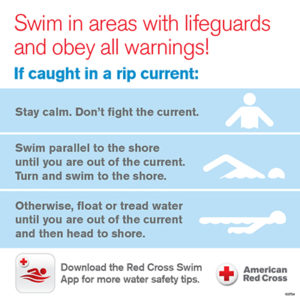By Dr. Peter G. Wernicki
As Hurricane Cristobal moves slowly up the Atlantic and Hurricane Marie tears through the Pacific, they are bringing high surf to vacation spots along both coasts and tempting surfers and adventurous swimmers to run headlong into the beckoning waves.
But it’s easy to forget that beneath those breakers there may be a danger that doesn’t advertise: deadly rip currents that can pull surfers and swimmers too far out to sea. Unfortunately, every year, even strong swimmers drown due to rip currents they either didn’t expect or didn’t respect.
So before you head to the shore, remember safety tips from the American Red Cross:
- Keep Clear. Swim at least 100 feet away from piers and jetties which often have permanent rip currents. A break or gap in waves, churned up sand and clusters of seaweed being pulled out to sea can also signal a rip current.
- Stay Calm. If you are caught in a rip current, keep calm – you’ll think more clearly.
- Don’t Fight It. Don’t try to swim against the current. Swim parallel to the shoreline until you are out of the current. Then swim at an angle away from the current toward the shore.
- Ride It. If you can’t swim out of the current, float or calmly tread water. When you float out of the current, swim toward the shore.
- Make Waves. If you are still unable to reach the shore, draw attention to yourself by waving an arm and yelling for help.
- Help, Don’t Hinder. If you see someone in trouble, get help from a lifeguard. If a lifeguard is not available, have someone call 9-1-1. Throw the victim something that floats – a lifejacket, cooler or an inflatable ball. Yell instructions on how to escape the current. Don’t try to swim out to help them — many people drown while trying to save someone else from a rip current.
- Swim Smart. Remember to avoid stormy seas, always swim sober, never swim alone and swim only at a lifeguard-protected beaches. Even confident swimmers should be sure they have enough energy to swim back to shore.
Get current on rip currents and make your dash into the waves a safe one!
Dr. Wernicki is Chair of the American Red Cross Scientific Advisory Council Subcouncil on Aquatics. The Council is a panel of nationally recognized experts drawn from a wide variety of scientific, medical, and academic disciplines. The Council guides the Red Cross on preparedness and emergency procedures and practices that align with the latest evidence-based scientific and medical knowledge.

